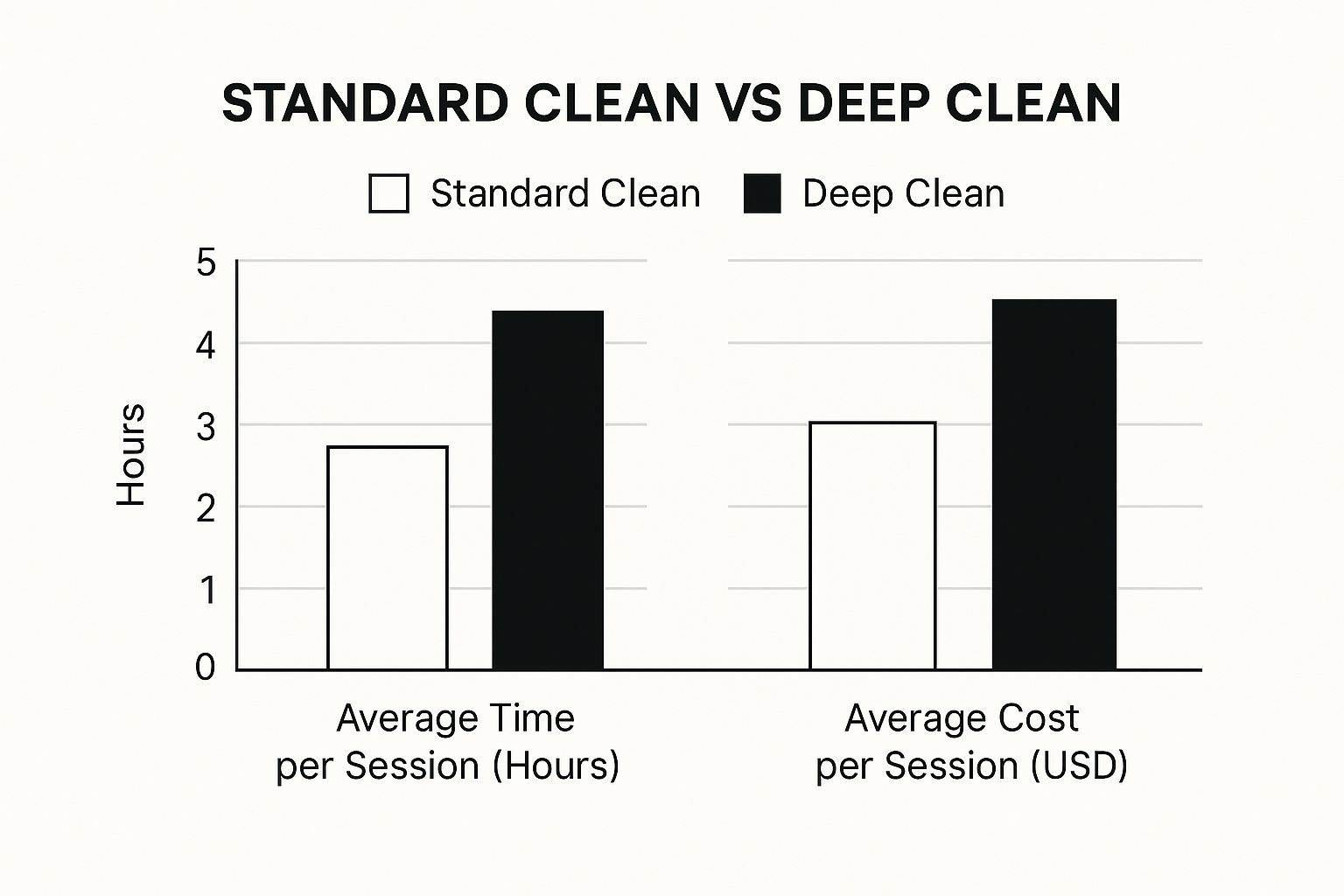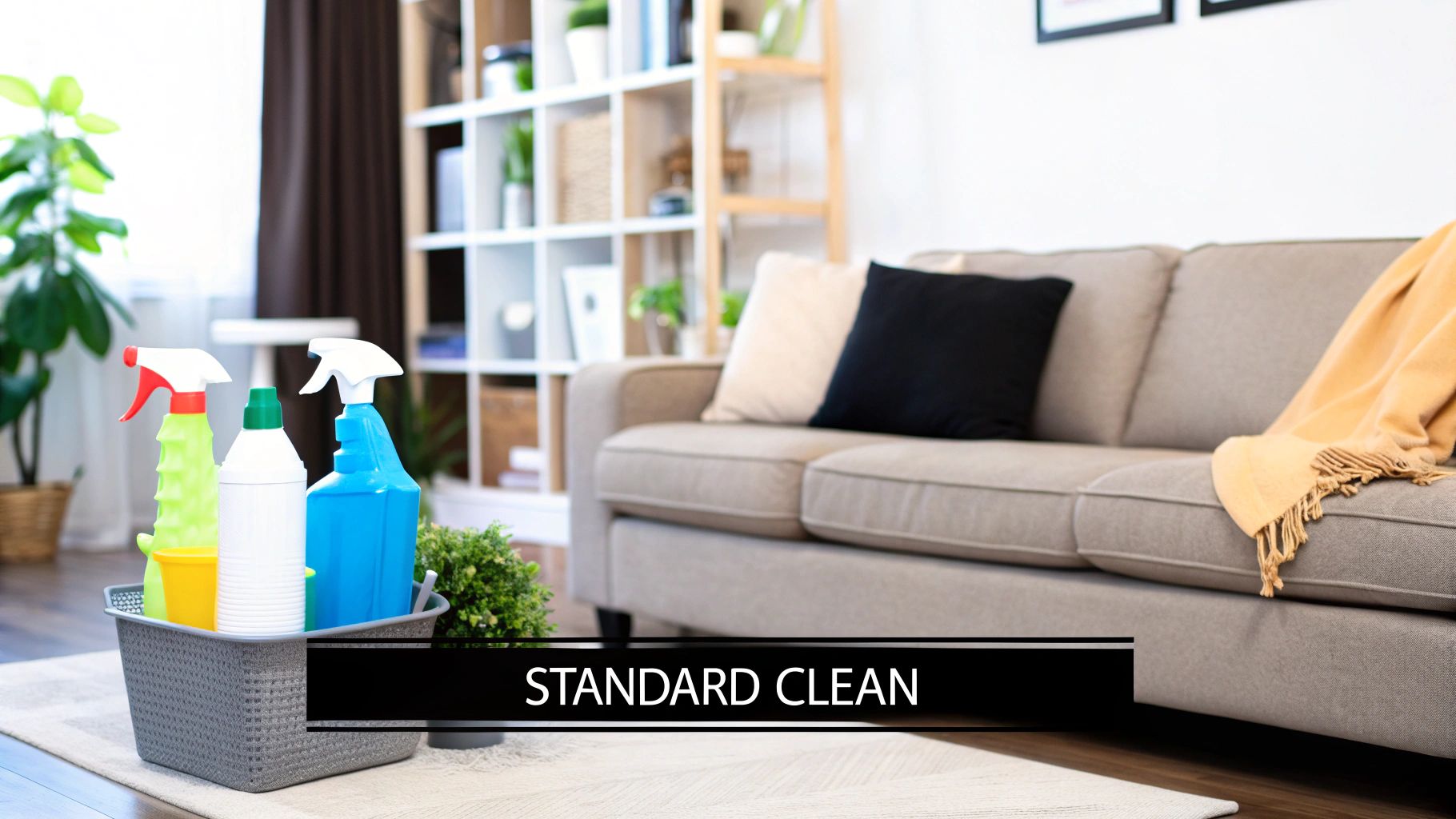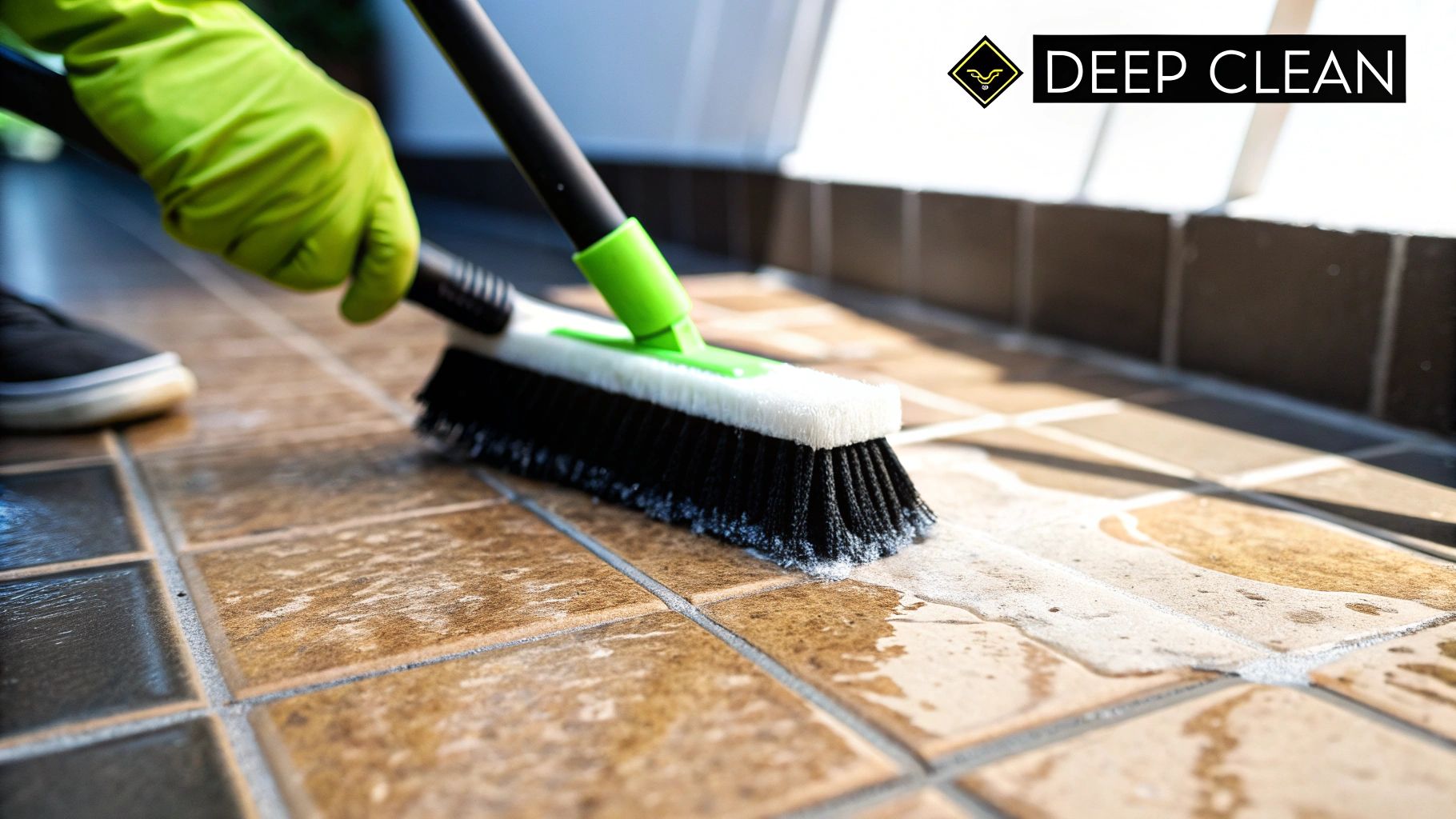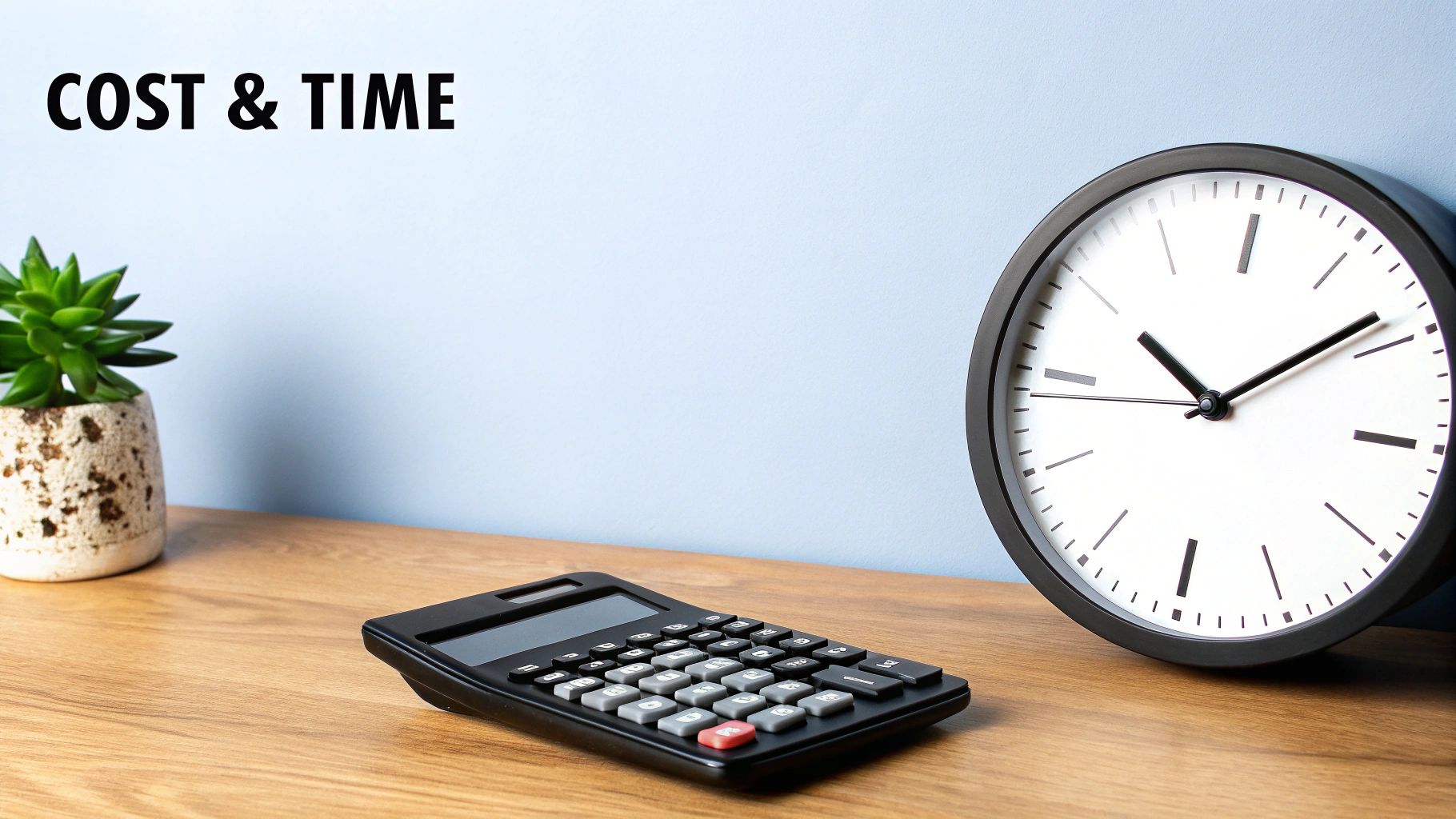When you’re trying to decide between a deep clean and a standard clean, it helps to think of it like this: a standard clean is for maintenance, while a deep clean is for restoration. One keeps your home looking good week to week, and the other hits the reset button on years of hidden grime.
Understanding the Core Difference in Cleaning
A standard clean is your home’s regular tune-up. It’s designed to manage the everyday mess that comes with an active household, focusing on the high-traffic areas to keep dust and clutter from taking over. Think of it as the recurring service that maintains a baseline level of cleanliness, making your home consistently pleasant to live in.
A deep clean, on the other hand, is a whole different beast. It’s an intensive, detail-oriented project that eliminates months or even years of built-up dirt, grease, and grime in all the spots a standard clean just doesn't cover.
The real goal of a deep clean isn't just to tidy up—it's to sanitize and restore. It gets to the root of the grime in those hard-to-reach places, which can dramatically improve your home's air quality and overall health.
Standard Clean vs Deep Clean At a Glance
To settle the deep clean vs standard clean debate for your own home, it's useful to see the tasks laid out side-by-side. While both services make your home a better place, their purpose and scope are worlds apart.
This table breaks down the fundamental differences.
| Aspect | Standard Clean | Deep Clean |
|---|---|---|
| Purpose | Routine maintenance and tidiness | Restoration and sanitation |
| Frequency | Weekly, bi-weekly, or monthly | 1-2 times per year or for special occasions |
| Kitchen Focus | Wiping counters, cleaning sink, sweeping | Cleaning inside appliances, scrubbing grout |
| Bathroom Focus | Wiping vanities, cleaning toilets | Descaling fixtures, deep scrubbing tubs |
| General Tasks | Dusting surfaces, vacuuming floors | Washing baseboards, cleaning light fixtures |
As you can see, a deep clean is far more comprehensive, which is why it's recommended less frequently. It's the heavy-lifting service that sets the stage for easier, more effective standard cleans.
The chart below shows how these differences in scope impact the time and cost involved.

A deep clean is a much bigger investment of time and money, and for good reason—it’s a labor-intensive process that leaves no stone unturned. That’s why it’s not a weekly task but a strategic service you book periodically to keep your home in its best shape.
What a Standard Cleaning Service Delivers

Think of a standard clean as the regular tune-up for your home. It’s the consistent, scheduled service that keeps a healthy and welcoming space by tackling the messes of everyday life. This isn't about a dramatic overhaul; it’s all about maintenance.
Most people schedule these weekly, bi-weekly, or monthly to keep high-traffic areas in check. It’s designed to stop the endless build-up of dust, crumbs, and daily grime before it gets out of hand, keeping your home consistently fresh.
Core Tasks in a Standard Clean
The checklist for a standard clean is pretty straightforward. It hits all the visible surfaces that get dirty the fastest. The whole point is to manage the “what” and “where” of day-to-day living.
A typical service always covers these basics:
- General Tidying: Lightly organizing common areas like living rooms and bedrooms to cut down on clutter.
- Surface Dusting: Wiping down all the easy-to-reach surfaces, including tables, shelves, and window sills.
- Floor Care: Vacuuming all carpets and rugs, plus a thorough sweep and mop of any hard floors.
- Kitchen Maintenance: Wiping countertops, cleaning the outside of appliances, and scrubbing the sink.
- Bathroom Essentials: Cleaning and sanitizing toilets, wiping down sinks and vanities, and polishing mirrors.
These tasks form the backbone of a tidy home, making sure dust and common allergens are dealt with regularly. This consistency is what keeps your home in good shape between those more intense cleanings.
A standard clean is all about what you see on the surface. It manages the present but isn't built to erase the past—a key difference in the deep clean vs standard clean conversation.
What Is Intentionally Left Out
It’s just as important to know what a standard clean doesn’t do to set the right expectations. These services are streamlined to be efficient and consistent, which means they have to skip the more time-consuming jobs.
For instance, a standard clean won't cover:
- Scrubbing tile grout in the bathroom or kitchen
- Washing interior windows and window tracks
- Cleaning inside appliances like the oven or refrigerator
- Moving heavy furniture to clean behind or under it
- Washing baseboards, door frames, or walls
These aren't forgotten tasks; they're the boundary that defines the service. They represent the caked-on, deep-set grime that a maintenance-focused clean simply isn't designed to handle. This is exactly where a deep clean comes in, tackling all the dirt that routine tidying leaves behind.
The Anatomy of a Professional Deep Clean
 A professional deep clean goes far beyond a simple tidying up—it’s more like a restoration project for your home. While a standard clean keeps things looking nice on the surface, a deep clean is designed to get rid of the stubborn grime, allergens, and bacteria that build up over time in places you probably don't even think about.
A professional deep clean goes far beyond a simple tidying up—it’s more like a restoration project for your home. While a standard clean keeps things looking nice on the surface, a deep clean is designed to get rid of the stubborn grime, allergens, and bacteria that build up over time in places you probably don't even think about.
This isn’t just wiping down a counter; it’s scrubbing the grout lines between your tiles. It’s not just vacuuming the floor but moving the entire sofa to get the dust that’s been hiding for months. This attention to detail is the real difference when you’re comparing a deep clean vs standard clean.
Beyond the Surface Level Tasks
A deep clean resets your home's hygiene by tackling the jobs everyone puts off. It’s a painstaking process where cleaners get into every corner, from dusty light fixtures way up high to the scuffed-up baseboards along your walls.
This service includes tasks often missed during regular cleaning, such as:
- Intensive Kitchen Cleaning: Scrubbing the inside and outside of appliances like ovens and refrigerators, degreasing stovetops and range hoods, and cleaning inside cabinets.
- Detailed Bathroom Sanitation: Descaling shower heads and faucets to get rid of mineral buildup, deep scrubbing tubs and showers, and sanitizing toilets, sinks, and vanities.
- Comprehensive Dust and Grime Removal: Washing baseboards, door frames, and window sills, plus cleaning behind heavy furniture and appliances.
The demand for this kind of thorough cleaning is a major reason the global house cleaning services industry is projected to grow from USD 60 billion in 2024 to USD 100 billion by 2033. This surge is fueled by a growing focus on health and removing allergens that a standard clean just can't handle.
The Long-Term Health and Home Benefits
Sure, a deep clean leaves your home looking spotless, but the real value is in the long-term benefits for your family's health and your property. By getting to hidden contaminants, this service creates a much healthier living space.
A deep clean is a health-focused service. It drastically improves indoor air quality by removing layers of dust, pet dander, and other allergens trapped in carpets, upholstery, and hard-to-reach areas, which can be a game-changer for anyone with allergies or asthma.
Ultimately, a periodic deep clean does more than just make your home look good—it protects its value. Preventing the long-term buildup of grime and mildew is a smart investment in the longevity of your fixtures, surfaces, and appliances. To see how the pros get it done right, check out our guide on essential deep cleaning checklists for professional maids.
Comparing the Cost and Time Investment
 When choosing between a deep clean and a standard clean, the two biggest questions are almost always "How much?" and "How long?" It's a fair question. The price gap isn't just arbitrary—it directly reflects the huge difference in labor, detail, and time needed for each service.
When choosing between a deep clean and a standard clean, the two biggest questions are almost always "How much?" and "How long?" It's a fair question. The price gap isn't just arbitrary—it directly reflects the huge difference in labor, detail, and time needed for each service.
A deep clean is a full-blown project, not just a quick tidy-up. This intensive approach naturally takes more time. For instance, a standard clean for a typical two-bedroom apartment might take a pro 2 to 3 hours. That same apartment could easily require 5 to 6 hours or more for a deep clean to hit every last corner and crevice.
Deconstructing the Pricing Models
Cleaning services usually stick to a couple of common pricing models. A standard clean is often a flat-rate service because the checklist is predictable and consistent. This makes it a breeze to budget for regular weekly or bi-weekly maintenance.
A deep clean, on the other hand, is a different beast. It's usually priced hourly or by square footage because of how much the scope can vary. The home's current condition, its size, and any special requests all play a part in the final cost. This flexible pricing ensures you're only paying for the work it takes to get your home back to a pristine state.
Even with professional help, you can make daily upkeep more efficient. We have some fantastic tips in our guide on how to speed clean your home that can help you stay on top of things.
A deep clean shouldn’t be seen as just another expense. It's a strategic investment in your home’s health and longevity. The higher cost covers the removal of deep-seated grime and allergens that a standard clean can't reach.
Cost and Time Investment Comparison
To give you a clearer picture, let's break down what you can expect to invest in each type of service. The following table provides typical ranges, but remember that quotes will vary based on your location and specific needs.
| Factor | Standard Clean | Deep Clean |
|---|---|---|
| Average Time | 2-3 hours (for a 2-bed home) | 5-6+ hours (for a 2-bed home) |
| Pricing Model | Often a flat fee | Typically hourly or per square foot |
| Cost Range | $120 - $180 | $250 - $450+ |
| Value Focus | Ongoing maintenance & tidiness | Restoration & intensive sanitation |
We've seen some interesting shifts in pricing for deep cleaning services lately. The national average cost has climbed to $55-$65 per hour, and the average rate per square foot is now around $0.27. This trend reflects the higher standards and greater demand for thorough, top-to-bottom sanitation.
For a broader perspective on industry trends, you can find more cleaning industry statistics on BookCleanGo.com. This data really drives home the point that a deep clean is a premium service designed to deliver premium, lasting results.
When to Choose a Deep Clean for Your Home
Figuring out when to book a deep clean versus a standard clean really comes down to the situation. While a standard clean is perfect for keeping things tidy week to week, a deep clean is a much more powerful, focused tool. It’s what you need for those specific moments when your home requires a total hygiene reset, not just a surface-level spruce-up.
Think of it as a strategic move. Certain life events and milestones call for a level of cleanliness that routine maintenance just can't deliver. These are the times when you should absolutely opt for a deep clean.
Key Scenarios for a Deep Clean
The need for a deep clean is almost always triggered by a major event. It’s less about sticking to a rigid schedule and more about responding to what your home—and your life—needs. The entire goal is to bring your space back to a pristine, "like-new" state.
Here are the most common situations where a deep clean is the only way to go:
- Moving In or Moving Out: This is non-negotiable. A move-out clean ensures you leave the property in fantastic shape for the next occupants and is often essential for getting your security deposit back. A move-in clean is just as important—it sanitizes the entire space, wiping out any germs or allergens left behind by previous residents.
- After Home Renovations: Construction kicks up a shocking amount of fine dust and debris that settles into every nook and cranny. A deep clean is the only effective way to get rid of that gritty residue from every single surface, vent, and fixture.
- Preparing for a Major Event: Hosting a holiday dinner, a big party, or having guests stay for an extended period? A deep clean makes sure your home is immaculate and ready to impress, taking care of all the little details you might not have time to tackle.
A deep clean is your home’s reset button. It is especially critical for health-related situations, such as managing severe allergies or disinfecting a home after a family member has recovered from an illness.
Seasonal Resets and Health-Related Needs
Beyond those big events, a deep clean is also a perfect seasonal refresh. The classic annual "spring cleaning" is a great example, where you finally scrub away the grime that’s built up over the winter. This goes far beyond simple decluttering; it’s about deep scrubbing and sanitizing.
For families dealing with allergies, a periodic deep clean can make a world of difference. It drastically reduces triggers like dust mites, pet dander, and pollen that get trapped deep in carpets, upholstery, and hidden corners. This kind of thorough cleaning doesn't just remove irritants—it improves your indoor air quality and makes your home a much more comfortable place to be.
To make sure nothing gets overlooked, using a detailed house deep cleaning checklist is a fantastic way to guide the process and guarantee every critical area is addressed.
Frequently Asked Questions About Home Cleaning
Deciding between a deep clean and a standard clean brings up a lot of practical questions. Getting straight answers helps you pick the right service with confidence, making sure you get exactly what your home needs. We’ve pulled together a few common questions to clear up any lingering confusion.
How Often Should I Get a Deep Clean?
For most homes, a professional deep clean one to two times per year is the sweet spot. This schedule is usually enough to hit the reset button on your home’s hygiene, cut through built-up grime, and maintain areas that a standard clean doesn't cover.
However, some situations call for more frequent deep cleaning. You might want to schedule one every 3-4 months if your household has:
- Pets that shed hair and dander
- Family members with bad allergies or asthma
- Young kids who are always playing on the floor
Do I Need to Provide Cleaning Supplies?
Nope, you can leave that to the pros. Professional cleaning companies come fully loaded with their own high-quality, commercial-grade products and tools. We're talking everything from specialized vacuums to powerful, yet safe, cleaning agents.
It’s always a good idea to double-check with your provider when you book, just in case. If you prefer specific products—like certain eco-friendly or hypoallergenic brands—mention it beforehand. Most services are happy to see if they can accommodate your request.
One of the biggest perks of hiring a professional service is getting access to their specialized equipment and supplies, which are often far more effective than what you can buy at the store.
Can I Customize My Cleaning Service?
Absolutely. A good cleaning service is all about flexibility. While companies use standard checklists to define a deep clean vs standard clean, these are almost always starting points that can be tailored to your home’s specific needs.
You can ask for extra attention on problem areas, like giving the bathroom grout a serious scrub or deep cleaning the kitchen cabinets. On the flip side, you can also tell the cleaners to skip a room or a task entirely. The key is clear communication before they start—it’s the best way to make sure your expectations are met and you get the most out of the service.
Ready to see what a professional clean can do for your home? Custom Maids has been Mid-Michigan's go-to choice for residential cleaning since 1982. Whether you need a one-time deep clean or ongoing maintenance, we’ll make your home spotless. Schedule your free consultation today at https://custom-maids.co.

